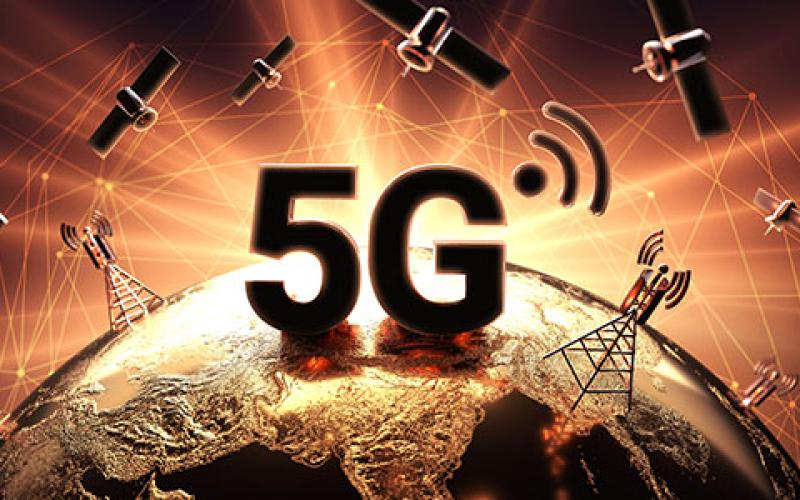
The Pentagon is adding projects for 5G experimentation.
A top Trump adviser outlines a blueprint for experimenting with wireless tech on bases and using software to counter China’s lead in hardware
Will Night / WIRED
(August 13, 2020) — The US government thinks the military could help whip the country’s 5G industry into shape.
Michael Kratsios, the acting undersecretary of defense for research and engineering, Thursday laid out a plan to turn US military bases into sandboxes for 5G experimentation. He also described a vision for advancing US military use of 5G, microelectronics, and artificial intelligence technology to counter one big threat — China.
“An emboldened and increasingly aggressive Chinese Communist Party is building and deploying some of the most advanced weapons,” Kratsios said in remarks prepared for a virtual event hosted by Georgetown University. He said China is using its “newfound economic and technological power to undermine our safety, our security, and our freedom.”
5G is the much-ballyhooed new wireless technology that promises download speeds of up to a gigabit per second — more than 20 times faster than today’s networks — as well as lower latency and much more capacity for devices.
Backers hope 5G will enable a new generation of smartphones and propel advances in manufacturing, autonomous driving, medicine, and other industries. But the rollout has been slower in the US than in some other countries, and the government is concerned about falling behind or seeing billion-dollar companies emerge elsewhere to take advantage of 5G, especially in China.
Kratsios, who also serves as the US government’s chief technology officer and as an adviser to President Trump on technology matters, says using military bases to test 5G will help companies surmount usual regulatory requirements. Companies will be invited to experiment with software for managing 5G networks as well as specific applications using 5G such as augmented reality.
“If one of our telecom companies wants to do a test in, say, Reno, Nevada, the amount of regulatory hurdles they need to go through is extraordinarily daunting and bureaucratic,” he told WIRED ahead of the speech. “The DOD can be a home for testing technologies that could have massive upside to [military] deployment, but also for the nation at large.”
Kratsios believes the effort will allow the Pentagon to gauge the military potential of 5G, for example in controlling drones or allowing for remote surgery, while also spurring American tech companies to develop competitive 5G offerings. Currently, the best 5G hardware comes from manufacturers in China and Europe. “This is about finding domestic alternatives to Huawei, Nokia, and Ericsson, ones that play to the software strengths of the United States,” Kratsios told WIRED.
/arc-anglerfish-arc2-prod-mco.s3.amazonaws.com/public/UFZENP6I5RDIPD5GETNURMLQT4.jpg)
Here’s everything you’ll ever want to know about the spectrum, millimeter-wave technology, and why 5G could give China an edge in the AI race.
Kratsios said 5G networks in the US should be built on “software-driven architecture standards.” Promoting the use of open standards would make it more difficult for Huawei or any other company to lock users into one platform, and could let US software companies play a role in defining critical features.
The US government has targeted Huawei, widely considered a world leader in 5G, with sanctions designed to cut off its supply of critical components. It has also pushed other countries to ban Huawei’s equipment from their networks. The US accuses the company of stealing intellectual property and says its close ties to the Chinese government make it a security risk. In recent weeks, the administration has upped its actions aimed at countering China’s technological prowess and advantage, threatening to ban the Chinese-owned social apps TikTok and WeChat.
In his role at the DOD, Kratsios oversees the department’s research and defense budget, as well as innovation focused divisions including the Defense Advanced Research Projects Agency, which funds blue-sky research related to national security.
In his Georgetown speech, Kratsios laid out a vision of the US locked in a high-stakes battle with China for supremacy in economic, technological, military, and ideological spheres. To stay ahead, he said, the US military needs to work more closely with the tech industry.
Over the years, the Pentagon helped fund the development of some world-changing technologies, including the Global Positioning System, the Internet, and artificial intelligence. In recent years, though, innovation has increasingly come from tech startups and companies like Google rather than DOD-funded projects or conventional military suppliers.
Kratsios himself has connections to Silicon Valley. Before joining the Trump administration, he was chief of staff to Peter Thiel, a billionaire investor and Trump supporter. Thiel cofounded Palantir, a startup that serves in the intelligence community and also invested in Anduril, a company developing military systems using recent advances in areas like AI.
Elsa Kania, a senior fellow at the Center for New American Security who has studied China’s adoption of 5G, says it is important for the US to accelerate the testing of military applications and to focus on ensuring America’s 5G industry is secure and robust. She says this should be more of a priority than targeting apps like TikTok and WeChat.
Kania adds that China does have strong ties between its military and tech industry, but notes that, ironically, that play was inspired by the US. “In some respects what China is trying to achieve with its military-industry fusion is to re-create elements of the American innovation ecosystem that have been singularly successful,” she says.
Posted in accordance with Title 17, Section 107, US Code, for noncommercial, educational purposes.